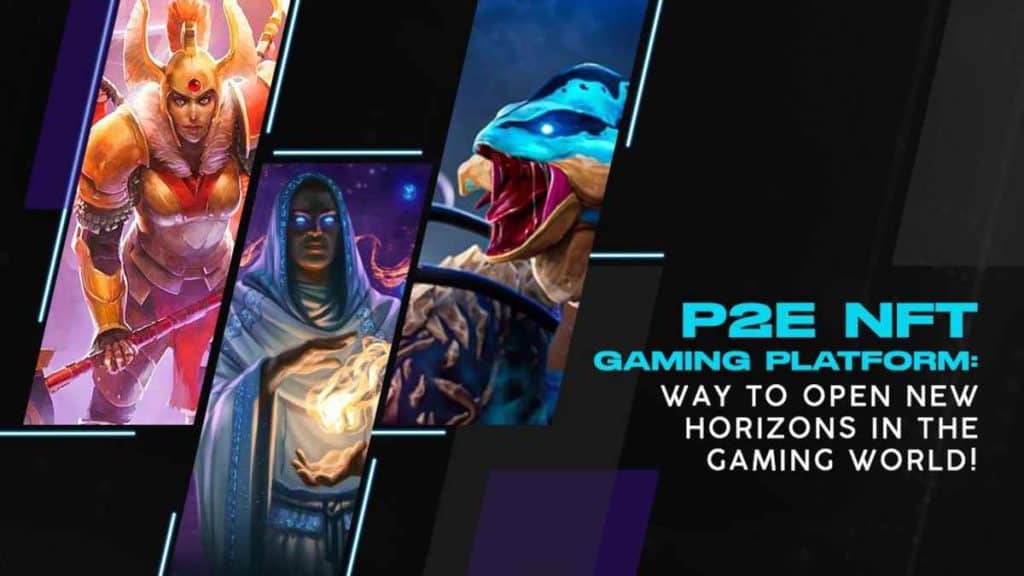The word has spread that games are no more simple games; they could be powerful peripherals for people to earn passive income. Sounds impossible in plain sight? It might have been earlier, but times have changed. While professional gamers and streamers could earn with Web2 games, their presence was more of envy as chances for a common gamer to do so were less, if not none. Cometh Web3 and procedures changed drastically, as there were no restrictions to earn through playing games, enabling a huge community of general gamers to join the movement. As we progress further, we will learn how can change the gaming industry from a business perspective to gain better insights.
For Those Who Feel Overwhelmed, Here’s More about P2E NFT Games
If the above introductory snippet confused you more than making things clear, here’s your part. Simply put, a Play-to-Earn NFT gaming platform is one where players can earn crypto rewards while playing and cash them later in the real world. From a business perspective, gaming studios can still earn through various other means, which will be discussed later. By providing provisions for people to reward their time and efforts put into an application, P2E NFT games mingle gaming ventures and gamers together from a position of conflict over ultra-high pricing of products, as in the case of popular Web2 gaming studios.
Is It Possible to Develop Such a Game for Any Genre?
Yes, it is absolutely possible to build a Play-to-Earn NFT gaming platform for any genre one may like. NFT games are commonly based on action, adventure, arcade, battles, simulations, MMORPG, MMORTS, racing, sports, trading cards, boards, and fantasy sports. In essence, every Web3 game looks similar to its Web2 counterparts; the system behind token usage and earning mechanisms brings all the difference.
Talking about Tokens, What Type of Tokens are Utilized Here?
Non-fungible tokens (NFTs) and cryptocurrencies are the main elements of Web3, which everyone knows at this moment, and these are utilized in Play-to-Earn NFT gaming platforms. While the former is employed to back in-game assets such as characters, armor, skins, weapons, vehicles, equipment, potions, and property, the latter serves as in-game currency and sometimes, even voting tokens. Ensuring that every element in the game is covered by these tokens is essential to launching a Web3 game or testing Web3 capabilities in an existing Web2 game. There are various token standards that can be used to create these tokens. While we know crypto tokens and NFTs have different standards, there are divisions inside NFTs for multiple reasons.
Popular Games in the Web3 World Right Now!
It has been a while since the first Play-to-Earn NFT gaming platforms started humbly. Now, numerous platforms promise gamers they can help incentivize their time and efforts. Presented below is information on the top games ruling the current-day Web3 gaming world.
● Splinterlands
Splinterlands is a trading card-based Play-to-Earn NFT gaming platform. Although the gameplay might be similar to Pokemon, the addition of NFTs to the mix adds spice to the game. In this game, players can fight tactical battles to earn rewards. The cards can also be traded secondarily without any hindrance that elevates the experience. The game is supported on the Ethereum, WAX, TRON, and Hive networks, increasing compatibility. As a venture, this game can benefit one through charges for secondary trades, initial purchases, and other booster options.
● Axie Infinity
Perhaps the most popular Play-to-Earn NFT gaming platform, Axie Infinity, boasts a huge community. Its developers are grinding hard to decentralize the entire game within a few years. The game is battle-based, with players needing to fight the environment or other players with unique little monsters called “Axies.” These monsters are backed by NFTs, and players earn cashable rewards for winning battles. The Axie Marketplace has been among the top-grossers for a long time as gamers are actively trading in-game items through the platform. Such a game’s requirement to spend upfront is a major profiting point for a gaming venture looking to utilize an engaging Web3 gaming model.
● Decentraland
Already on its way to becoming the first-ever fully functional metaverse, Decentraland is basically another top Play-to-Earn NFT gaming platform based on traditional simulation games. Here, players need to get their digital avatars, buy a piece of virtual real estate, and build their own platform. It can be a storefront, a game, or an art gallery. Or users can even enter games that others had built and win rewards. All these for a business might sound far off from their intentions. However, gaming studios can still make money by developing mini-games and levying charges for using elements of the metaverse.
● Zed Run
One of the products resulting from smart thinking and long-time wishes, Zed Run is a Play-to-Earn NFT gaming platform based on digital horse racing. While players themselves do not need to participate in races like in other motor races, they should breed and build their stables to compete. The game is based on thousands of algorithms that are randomly executed. Such tactic-based games are still loved by gamers, which will help garner profits for game studios, and adding a unique idea only increases the gain margins.
Final Thoughts
Therefore, we can say that a Play-to-Earn NFT gaming platform can be ideal for businesses looking to make the most of the . If you are interested in making inroads with your novel gaming idea, consider working with an experienced NFT game development company to realize your ideas and top the Web3 gaming world.


